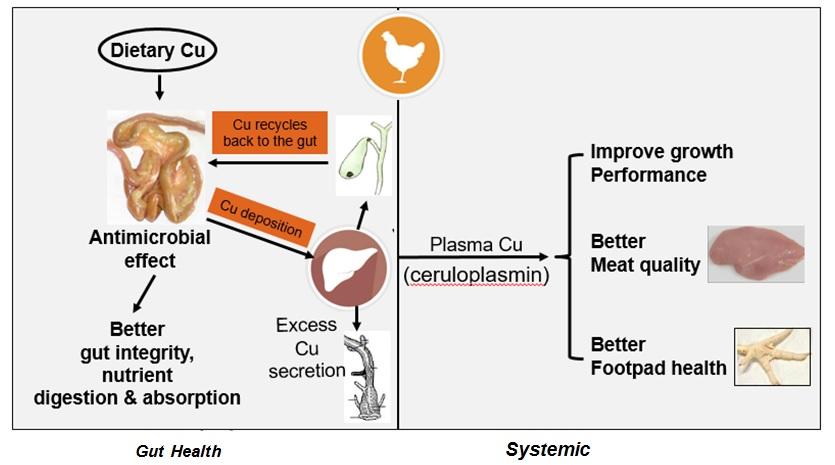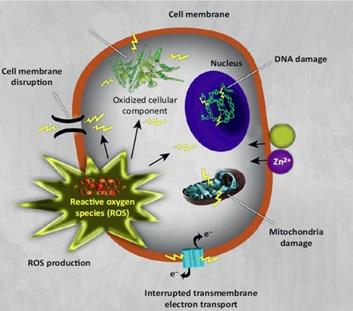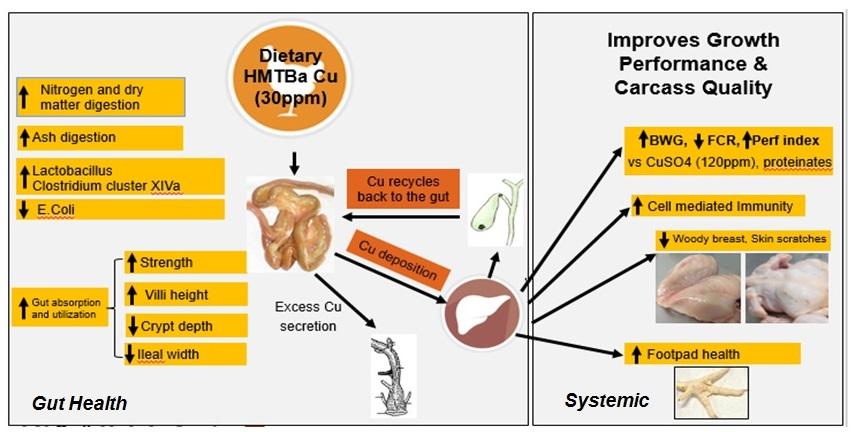Benefits of Chelated Copper in Poultry Diet
Published: August 5, 2020
By: Dr. Koushik De, Technical Director – South Central Asia, Novus International
Copper (Cu) has been widely used at pharmacological levels (e.g., 125 ppm) as growth promoter in poultry. However, the mechanism by which high levels of Cu promote growth remains to be determined. It is commonly recognized that Cu exerts anti-microbial effect in the gut but there is not much direct and consistent data showing that Cu alters the population of bacterial species in birds. And copper can maintain proper body functions and obtain the optimal growth performance of poultry (Banks et al. 2004). Also, copper is a cofactor for various enzymes such as cytochrome oxidase, lysyl oxidase and Cu-Zn superoxide dismutase (Davis & Mertz, 1987). Basing on the central role in various vital proteins, deficiency and toxicity, Leeson (2009) reported that copper deficiency could cause severe health problems including growth depression, disability of bones, poor feathering and anemia. Copper additive in the diet, proved that it has a beneficial effect on weight gain, feed conversion ratio and modification of the bacterial microflora in the alimentary tract (Ruiz et al. 2000; Nys, 2001). Moreover, Copper is also regarded as a growth promoter in the poultry aspect of breeding (Kim et al. 2011), considering that the use of antibiotic as growth promoters is prohibited by the European Union. However, an overdose of copper (100-250 mg/kg) can restrict the growth of chicks (Nys, 2001). Therefore, the optimal level of dietary copper should be determined.
Mode of Action of Cu:
Dietary Cu is absorbed in the illeal region and then transported to liver which acts as a major store and from there to other extra hepatic tissue via ceruloplasmin. After that liver will recycle Cu to the gut through its bile secretion which will either make it reabsorbed and exhibit some gut health benefits or excreted if it’s in excess which may raise some economic concern.

Ceruloplasmin is the major copper carrying protein in blood and play major role in iron metabolism. It transport >95% of total serum Cu which again has some systemic effect.
Copper requirements in broiler chickens:
According to NRC (1994) the requirement of Cu for broiler is 5-8 mg/kg and 3–10 mg/kg according to FEDNA (2008). European Union (EU), dietary copper is supplied for poultry up to a maximum of 25 mg/kg (EFSA, 2012). Other areas of the world, including USA and Brazil, the poultry industry adds 125 ppm to 250 ppm Cu in the diets as growth promoters (Pesti and Bakalli, 1996). In SCA the typical usage is around 50-80 ppm Cu in diet.
Advantage of Higher Cu inclusion in diet:
There are some suggested mechanism of actions by which Cu helps in performances. Copper has a direct growth promoting effect by increasing the expression of Ghrelin and feed intake related genes (Biol Trace Elem Res, 2012, 150:154-157). Higher level of copper improve gut health by decreasing the intestinal crypt depth and lymphocytes (Poult Sci, 2006, 85: 999-1007) and it also increase the intestinal lipase activity particularly in the young animals (J Anim Sci. 1996, 74:1888-1896.).
Disadvantage of Higher Cu inclusion in diet:
Poultry feeds as inorganic mineral salts (copper sulfate pentahydrate), are mostly excreted in the feces and are a cause of environmental concerns.

High doses of Cu may also easily chelate phytate (Cheryan, 1980) and make it non-accessible for hydrolysis by phytase or absorption in the intestine (Pang and Applegate, 2006) and it can affect the availability of other trace minerals such as zinc, Iron, P, etc.
In Upper GIT and stomach where pH is very low (around 2.5) most of the molecules are opened up and start interacting with other particles and form complexes with either phosphorus or other trace minerals and when this complex reaches ileum, the major site of absorption, because of this antagonism molecules won’t be available for absorption which leads to reduced bioavailability. But a true chelated mineral (BIS Chelated) like HMTBa chelated minerals are protected from this antagonism and increase the bioavailability.
Mechanism of toxicity of Cu against bacteria:

Modified from Hajipour et. al. 30 (10), 499-511, 2012
Cu can produce free radicals, resulting in induction of oxidative stress (i.e., reactive oxygen species; ROS). The produced ROS can irreversibly damage bacteria (e.g., their membrane, DNA, and mitochondria), resulting in bacterial death.
Role of Cu in modulating Gut microbiota:

The Cu-Met was produced by reacting dl-Met and Cu sulfate and The Cu-SP was produced by reacting soybean digest and Cu sulfate. what we can see here is that antibiotic is reducing the total bacterial count and also other bacteria no matter its harmful or beneficial. But Cu in higher dose(100ppm) increasing the lactobacillus level & decrease the E coli level and numerically reducing the clostridium as well. The total microbiota is also significantly increased which implies that Cu is modulating the microbiota in gut rather than reducing it and shifting it towards a favorable population which is beneficial for the gut.
Chelated Cu improved cecal microbiota:

Clostridium cluster XIVa includes many known butyrate-producing bacteria. Butyrate is a preferred energy source for colonic epithelial cells and reported to improve growth performance, intestinal digestive and absorptive capacity. Clostridium cluster XIVa been reported to down-regulate bacteria virulence and gut inflammation. Lactobacilli has been associated with beneficial effects for the host, such as: (1) promotion of gut maturation, (2) gut integrity, (3) antagonisms against pathogens, and (4) immune modulation. Lactobacilli prevent hydroxy radical production and inhibit Escherichia coli and Enterococcus growth in system mimicking colon fermentation. Lactic acid bacteria has antimicrobial activity against food borne and human pathogens by producing various inhibitory components such as organic acids, hydrogen peroxides, bacteriocins. Chelated Cu @30ppm produce significantly higher amount of Clostridium cluster XIVa and Lactobacill and lower amount of harmful bacteria like E.coli which indicates improved cecal microbiota.
Chelated Cu Local effect in Gut:
- Increased Gut Breaking Strength: chelated Cu significantly increased intestinal breaking strength in cocci challenged birds.
- Increased Villus Height & height/width ratio: Higher villi height is important as it will give more site of absorption for nutrients and we need a lower width as higher width indicates inflammation. So higher height/width ratio indicates chelated Cu improves gut integrity.
- Decreased Crypt depth & Crypt depth /villus height ratio: Chelaed Cu lowers crypt depth and as a result it requires lower energy and nutrients to maintain the gut barrier function.
- Decreased Muscular layer thickness: Reduction in thickness indicates that Chelated Cu improves gut morphology and likely reduced energy and nutrient needs to maintain gut barrier function.

Ricardo et.al.ISPF, Atlanta 2017.
Chelated Cu improved BWG and FCR in broiler birds (Average of two trials):

Ricardo et.al.ISPF, Atlanta 2017.
When results are fitted it in a linear regression there is significant p value <0.05 which predicted 32 g increased but than CuSO4. Similarly, in FCR also which predicted 3.2 points better FCR in chelated Cu than CuSO4.
Chelated Cu improves local cell-mediated immune response:

Adapted from Corrier & DeLoach, 1990/ Ricardo et.al.ISPF, Atlanta 2017.
The birds were given intradermal injection of an antigen at the chicken paw and after 24 hrs measurement of the inter digital thickness of the membrane was taken. And if there is better cell mediated immunity the birds will react in a way to this antigen which measures in increased thickness compare to less immune birds. Here we can see that HMTBa chelated Cu @30ppm have significantly increased interdigital thickness compare to CuSO4 indicating that these birds are better immuned.
Chelated Cu reduced the incidence of moderate and severe woody breast in broilers of 42 d of age

Woody Breast Condition is characterized by tougher row of fillets. When we feel, it will feel like wooden. It can significantly reduce the quality of cooked meat product like less cohesive force and more tough which will even affect the further processing meat products. Using HMTBa chelated Cu @ 30ppm significantly reduces the incidence of this condition and improves the quality of cooked meat products.
Role of HMTBa Chelated Cu in improved footpad lesions and wound healing:

Healing process include inflammation phase when they got inflamed and have the lesions and to recover they need to provide blood supply to the tissue which is called Angiogenesis. And the cells are migrated to the lesion part to replace the damaged area where they proliferate and the collagen and fibrous tissue need to remodel to heal the lesion part. And we from Novus has identified few genes which play important role in each part of this process. And we found that HMTBa chelated minerals like Cu downregulate the genes for inflammation and upregulate the genes for angiogenesis to provide more blood supply to the lesion area and also upregulate genes for Migration and Collagen deposition. As a result, it improves foot pad lesions and fasten the wound healing process.

Summary and Conclusions:

Copper can play a strategic role in poultry health and growth. It can serve to reduce disease challenges and boost immune function. However, there are differences among sources of supplemental copper for both the bird and the environment. Feed manufactures should take care to use copper and other mineral sources that will maximize animal health while minimizing the mineral output in waste. Chelated HMTBa Cu nutrition offers opportunities to improve performance (feed conversion) and increase profitability. The use of 30 ppm HMTBa Cu optimizes FCR. One thing to remember the effect of Cu like growth promoter is independent of the effect of AGP and thus HMTBa Cu can help in improving FCR irrespective of the AGP programme.
Related topics:
Authors:
Novus
Influencers who recommended :
Kapil ManwalRecommend
Comment
Share
Recommend
Reply
6 de agosto de 2020
This article gives a full understanding about copper role in the poultry
Especially Mintrex copper helps in poultry
1. Growth promotors
2. Anti bacterial
3. How inorganic copper harmful and antagonist activity
4. By increasing the gut health
5.Reduce the footpad lesion
The comparative study with inorganic copper with Mintex copper gives full benefit of organic minerals
Excellent article easy undesirable.
Recommend
Reply

Would you like to discuss another topic? Create a new post to engage with experts in the community.
Featured users in Poultry Industry

Shivaram Rao
Pilgrim´s
PhD Director Principal de Nutrición y Servicios Técnicos de Pilgrim’s Pride Corporation
United States
United States







